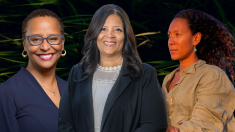"Why is Chicago so violent?"
I get this question a lot. I work in Englewood, a Black, South Side neighborhood known more for its violence and joblessness than strong block clubs and wide boulevards.
An international spotlight shines on Chicago as the city works to reduce violence. While answering such a complex question won’t yield a simple or comfortable answer, there are some shared characteristics about the places where the majority of violence lives.
The most brutal enclaves of the city are the most troubled—plagued with poverty, excessive unemployment, foreclosures, blight, food deserts, underperforming schools, high rates of preventable diseases, lack of economic development, etc.
Segregation, however, is rarely broached in Chicago violence discussions, but it’s impossible not see the connection. The most violent corners happen to be in the most racially isolated and poverty stricken areas. The handwringing around crime involves a lot of finger pointing, lamenting about lost Black youth, and expectations of police to solve violence by themselves. Each Monday morning, there are news reports about how many anonymous people got shot over the weekend. Chicagoans are reminded that more of our residents have died violently than the number of soldiers in Afghanistan.
These accounts don’t help solve violence, and they lack empathy.
So here’s a snapshot of a couple of high-crime neighborhoods:
Englewood is seven miles south of downtown Chicago. Originally settled by German and Irish immigrants, the neighborhood once boasted the second-busiest shopping district in the city. By the time Blacks started moving in during the 1950s, redlining (limiting or denying services to a community because of the race of its residents), a declining housing stock, and disinvestment were on the fast track.
According to city public health statistics, today, Englewood’s unemployment rate is 25 percent. Forty-two percent of the neighborhood's residents live in poverty; for children the number is almost double. The per capita income is less than $12,000 and 29 percent of residents have no high school diploma.
Now let’s go to North Lawndale, formerly the global home of Sears, Roebuck and Co. and five miles west of downtown Chicago. By the 1960s, Blacks replaced Jews in the West Side neighborhood. Housing became overcrowded and businesses packed up and left, which turned the area into a Black ghetto. The 1968 riots following the assassination of Dr. Martin Luther King Jr. cemented this status. City stats show that 39 percent of residents today live below the poverty level and 30 percent have no high school diploma. The median income is the same as Englewood’s. North Lawndale residents have higher cancer, stroke and diabetes rates than dozens of other Chicago neighborhoods.
The demographics of Englewood and North Lawndale paint an ugly picture of segregation and poverty—conditions that trigger violence. But as long as I’m pulling the curtain back on the two communities dogged by reputation and shackled to violent identities, I must reveal something else, a dirty little secret. Englewood and North Lawndale aren’t just despondent places with downtrodden Black folk waiting for handouts. Urban agriculture, families, cultural councils and hints of a resurgence in retail shops are a part of these communities, too (we'll talk about this more in a future article).
And there’s more to Black Chicago than violence. Our lives here are not all dismal and laden in poverty. According to the U.S. Census, the 33 percent of the city’s 2.7 million residents are Black, second to New York City with the largest Black population. The census shows that Black-owned firms in Chicago total 23 percent, reflecting how the city has long been the nation’s capital of Black businesses. Among them: Loop Capital and Burell Communications, Gallery Guichard and, of course, Johnson Publishing Company. Miles and miles of Black middle class neighborhoods extend throughout the city with trim lawns – distinguishing it from many high-density Black communities, say, on the East Coast. Chatham, Pill Hill, Auburn-Gresham, Park Manor, Jackson Park Highlands and the Hyde Park/Kenwood (where President Barack Obama’s mansion is) neighborhoods boast households led by Black doctors and Black postal workers alike.
But until poverty and segregation are addressed, the comfort of these Black archives will be both compromised and evasive to those living just blocks away.
Natalie Y. Moore is a reporter at WBEZ-Chicago and co-author of The Almighty Black P Stone Nation: The Rise, Fall and Resurgence of an American Gang.













